Do you have a question about the Porsche Cayenne 2009 and is the answer not in the manual?
Key safety warnings and recommendations for operating your Porsche.
Contact details for the National Highway Traffic Safety Administration (NHTSA).
Warnings against altering or misusing the vehicle.
Importance of checking vehicle for signs of damage.
Heed all operating instructions and special warnings for safety.
Warning about operating vehicle components while driving.
Danger of inhaling engine exhaust fumes, especially carbon monoxide.
Warning about chemicals known to cause cancer and birth defects.
Risk of burn injury from hot exhaust pipes.
Dangers associated with portable fuel containers (leakage, explosion, fire).
Risk of damage to SportDesign package components during off-road driving.
Information regarding the PCCB system and potential brake noises.
Engine requirements for optimal performance and fuel economy.
Recommendations and potential issues with fuels containing ethanol.
Essential pre-drive checks for vehicle safety and operation.
Recommendation for carrying essential emergency equipment.
Proper seating and control adjustments for safe driving.
Safe driving practices, defensive driving, and obeying traffic laws.
Tips for optimal performance and wear-in of new Porsche.
Importance of breaking in new brake pads and discs for optimal friction.
Advice on breaking in new tires and anticipating reduced traction.
Expected higher oil and fuel consumption during the break-in period.
Identification of key controls and features in the driver's cockpit.
Identification of controls and instruments on the steering wheel and cluster.
Identification of controls and features in the front center console.
Preventing vehicle theft by securing the car properly.
Information about the car keys, including replacement and folding.
Description of the central locking system and its components.
Overview of external vehicle access and locking procedures.
Detailed instructions for unlocking and locking the vehicle externally.
Procedures for unlocking and opening vehicle doors.
Procedures for locking vehicle doors.
Configuring audible and visual signals for door unlocking.
Activating rear access (lid, window, bracket) for central locking.
Configuring automatic door locking and unlocking functions.
Activating or deactivating daytime driving lights.
Proper adjustment of seats and headrests for safety and comfort.
Storing and recalling personalized seat, mirror, and steering wheel settings.
Convenience feature for easier entry and exit from the vehicle.
Location and removal instructions for the fire extinguisher.
Operation and temperature control for heated seats.
Guidelines for correct safety belt usage, care, and maintenance.
Explanation of airbag system function, safety precautions, and warnings.
Recommendations for installing and using child restraint systems.
Information on installing LATCH child seat systems.
Location and usage guidelines for child seat anchorages.
Instructions for adjusting, folding, and heating door mirrors.
Adjustment and automatic anti-dazzle function of the interior mirror.
Description of Tiptronic rocker switches, horn, airbag, and heating functions.
Manual and electrical adjustment procedures for the steering wheel.
Operation of the multi-functional steering wheel and its function keys.
Usage and care of sun visors, including the make-up mirror.
Operation and retraction of rear side window sun blinds.
Accessing the air conditioning control panel.
Description of Manual, 2-Zone, and 4-Zone AC systems.
Detailed operation of the manual air conditioning system.
Operation of the 2-zone automatic climate control system.
Operation of the 4-zone automatic climate control system.
Instructions for operating the vehicle's air vents.
Instructions for switching the heated rear window on and off.
Operation of the parking heater for heating and ventilation.
Instructions for operating power windows, including safety warnings.
Using the one-touch feature for front window operation.
Activating child protection to disable rear power windows.
Operating windows using the car key.
Operating windows using the door handle button.
Resetting window positions after battery disconnection.
Overview of sliding/lifting roof operation.
Safety warnings and operational readiness for the sliding/lifting roof.
Manual procedure for operating the sliding/lifting roof in emergencies.
Overview and operation of the panorama roof system.
Safety warnings and operational readiness for the panorama roof system.
Detailed instructions for operating the panorama roof system.
Functionality of the force limiter in the panorama roof system.
Operation of the light switch and automatic driving light assistant.
Adjusting the brightness of the instrument panel illumination.
Functionality of automatic headlight beam adjustment.
Operation of turn signals, high beam, and headlight flasher.
Switching the emergency flasher on and off.
Operation of interior lighting, including reading and rear lights.
Features for improved interior visibility and comfort lighting.
Illumination of the area around the doors for safety.
Overview and operation of windshield wipers.
Detailed operation and safety precautions for the wiper/washer stalk.
Identification of gauges and warning lights in the USA instrument panel.
Identification of gauges and warning lights in the Canadian instrument panel.
Explanation of various warning and indicator lights on the tachometer and speedometer.
Information on oil temperature, tachometer, clock, fuel, speedometer, and odometer.
Indication and action required for low fuel levels.
Description of speed and mileage displays.
Information on coolant level gauge and temperature warnings.
Meaning and measures for the check engine warning light.
Instructions for operating the multi-purpose display and its menus.
Steps to open the main menu and its functions.
Step-by-step guide to display and reset average consumption.
Information on tire pressure display and related warnings.
Displaying compass direction and navigation information.
Defining and activating a speed limit for monitoring driving speed.
Accessing and interpreting warning messages on the multi-purpose display.
Checking the ground clearance status with level control.
Checking status of locks and driving programs.
Displaying and resetting average fuel consumption.
Setting tire pressure monitoring system parameters.
Information on tire pressure monitoring faults and their meaning.
Temporarily deactivating the passenger compartment monitoring system.
Customizing vehicle door and rear lid locking/unlocking settings.
Configuring individual door unlocking preferences.
Activating or deactivating daytime driving lights.
Configuring the delay time for exterior lights.
Adjusting the vehicle's clock.
Setting the compass zone and calibrating the compass.
Selecting the display language for the multi-purpose display.
Selecting units for speed, consumption, temperature, and tire pressure.
Restoring all settings to factory defaults.
Operation and safety precautions for the ignition and steering lock.
Procedures for starting and stopping the engine, including safety warnings.
Instructions for applying and releasing the parking brake.
Description of the brake system, including warnings for operation and maintenance.
Information on brake pedal operation, overheating, and wear.
Instructions for using cruise control, including safety warnings.
Operation of the manual transmission and clutch, including safety and damage prevention.
Description of Tiptronic S operation, selector lever positions, and driving programs.
Explanation of on-road and off-road driving programs (Low Range, High Range).
Overview of integrated control systems like PTM, PSM, ABS, and Air Suspension.
Functional description and advantages of the PTM system.
Function and advantages of the PSM system for vehicle stabilization.
Function and advantages of the ABS system for driving stability.
Operation of the hillholder function for Tiptronic S vehicles.
Operation of the drive-off assistant for vehicles with manual transmission.
Assistance system for downhill driving.
Adjusting vehicle height using the air suspension system.
Function and selection of different running-gear setups.
System for roll stabilization of the vehicle body.
Guidelines and tips for safe off-road driving.
Instructions for folding and unfolding the rear seats.
Opening and closing the loadspace floor, including tie-down rings.
System for securing objects in the cargo area using telescopic bars and strap reels.
Instructions for pulling out, retracting, and removing the luggage cover.
Information on installing and using the luggage safety net.
Instructions for loading and stowing the ski bag.
Guidelines for fitting the roof transport system and associated safety precautions.
Tips for optimal FM reception and audio performance.
Operation of the PCM system, including navigation and satellite radio.
Connecting and using iPod, USB, and AUX devices.
Overview of various storage options within the vehicle.
Instructions for opening, locking, and cooling the glove compartment.
Instructions for using and removing the cupholder.
Instructions for opening, emptying, and using the ashtrays.
Operation and safety precautions for the cigarette lighter.
Procedures for hitching and unhitching a trailer, including electrical connection safety.
Definitions of towing terms and safety ratings for load limits.
Guidelines for securely stowing cargo in the vehicle.
Recommendations for safe driving practices when towing a trailer.
Functionality, readiness, and control of the ParkAssist system.
Interpretation of warning indicators and signal tones for ParkAssist.
Limitations of ultrasonic measurement and fault indications.
Using the passenger side mirror for parking assistance.
Programming and operating the garage door opener.
Description of the alarm system, its components, and avoiding false alarms.
Temporarily deactivating passenger compartment monitoring.
Procedures for activating the alarm system and passenger compartment monitoring.
General safety precautions and warnings for working on the vehicle.
Information on engine oil consumption, checking levels, and recommendations.
Procedures for checking and adding coolant, including warnings.
Instructions for checking and changing brake fluid, with safety warnings.
Procedures for checking and refilling washer fluid.
Instructions for checking and adding power steering hydraulic fluid.
Maintenance procedures for air cleaner and particle filter replacement.
Maintenance for automatic and manual transmission fluids.
Guidelines for maintaining and replacing wiper blades.
Explanation of the emission control system's function and efficient operation.
Advice on improving fuel economy through proper maintenance and driving habits.
Considerations for operating the vehicle in different countries.
Recommendations for fuel quality, refueling, and handling.
General guidelines for cleaning and preserving the vehicle's exterior and interior.
General safety precautions and warnings for working on the vehicle.
Information on tire wear, damage, safety, and maintenance.
Explanation of tire grading system for treadwear, traction, and temperature.
Guidelines for checking and adjusting tire pressures, including warnings.
Risks of overloading and information on load limits and tire pressure plates.
Procedures for dealing with tire damage and punctures.
Advice on selecting and fitting replacement tires and wheels.
Instructions and warnings for fitting and using snow chains.
Description of the tool kit components and their usage.
Instructions for using the jack safely for wheel changes.
Guidelines for fitting and removing wheel spacers.
Instructions for tightening and replacing wheel bolts.
Detailed procedure for changing a vehicle wheel.
Procedure for changing a wheel with spacer removal.
Guidelines for using and handling the collapsible spare wheel.
Instructions for using tire sealant for temporary repairs.
Safe procedures for lifting the vehicle using a jack or lift.
Information on the electrical system, sockets, fuses, and relays.
Instructions for locating and replacing fuses in the fuse boxes.
Safety precautions, charging, and maintenance for the vehicle battery.
Instructions for replacing the battery in the remote control key.
Procedure and safety warnings for jump-starting a vehicle.
Safety warnings and step-by-step instructions for replacing various bulbs.
Procedures for removing and installing headlight units.
Instructions for changing low/high beam and cornering light bulbs.
Instructions for changing gas discharge lamps in Bi-Xenon headlights.
Instructions for changing bulbs for turn signals and side marker lights.
Instructions for changing license plate light bulbs.
Procedure for adjusting headlights for proper beam alignment.
Instructions for repositioning headlights for different traffic sides.
List of exterior and interior lights with their types and ratings.
Guidelines and warnings for towing a vehicle.
Instructions for using the towing hook and associated safety precautions.
Comprehensive data on tire pressures, technical specifications, and dimensions.
Location and information contained in the vehicle identification number and data bank.
Explanation of safety stickers and tire pressure information.
Technical data for Cayenne, Cayenne S, and Cayenne GTS engines.
Gear ratios for manual and Tiptronic transmissions across models.
Specifications for tire and rim sizes for different models and seasons.
Cold tire inflation pressures for various tire sizes and loads.
Data on vehicle weights, load limits, and towing capacities.
Ground clearance specifications for different suspension levels.
Specifications for engine oil, coolant, brake fluid, and fuel capacities.
Exterior and interior dimensions of the vehicle.
Performance data including acceleration and top track speed.
Key safety warnings and recommendations for operating your Porsche.
Contact details for the National Highway Traffic Safety Administration (NHTSA).
Warnings against altering or misusing the vehicle.
Importance of checking vehicle for signs of damage.
Heed all operating instructions and special warnings for safety.
Warning about operating vehicle components while driving.
Danger of inhaling engine exhaust fumes, especially carbon monoxide.
Warning about chemicals known to cause cancer and birth defects.
Risk of burn injury from hot exhaust pipes.
Dangers associated with portable fuel containers (leakage, explosion, fire).
Risk of damage to SportDesign package components during off-road driving.
Information regarding the PCCB system and potential brake noises.
Engine requirements for optimal performance and fuel economy.
Recommendations and potential issues with fuels containing ethanol.
Essential pre-drive checks for vehicle safety and operation.
Recommendation for carrying essential emergency equipment.
Proper seating and control adjustments for safe driving.
Safe driving practices, defensive driving, and obeying traffic laws.
Tips for optimal performance and wear-in of new Porsche.
Importance of breaking in new brake pads and discs for optimal friction.
Advice on breaking in new tires and anticipating reduced traction.
Expected higher oil and fuel consumption during the break-in period.
Identification of key controls and features in the driver's cockpit.
Identification of controls and instruments on the steering wheel and cluster.
Identification of controls and features in the front center console.
Preventing vehicle theft by securing the car properly.
Information about the car keys, including replacement and folding.
Description of the central locking system and its components.
Overview of external vehicle access and locking procedures.
Detailed instructions for unlocking and locking the vehicle externally.
Procedures for unlocking and opening vehicle doors.
Procedures for locking vehicle doors.
Configuring audible and visual signals for door unlocking.
Activating rear access (lid, window, bracket) for central locking.
Configuring automatic door locking and unlocking functions.
Activating or deactivating daytime driving lights.
Proper adjustment of seats and headrests for safety and comfort.
Storing and recalling personalized seat, mirror, and steering wheel settings.
Convenience feature for easier entry and exit from the vehicle.
Location and removal instructions for the fire extinguisher.
Operation and temperature control for heated seats.
Guidelines for correct safety belt usage, care, and maintenance.
Explanation of airbag system function, safety precautions, and warnings.
Recommendations for installing and using child restraint systems.
Information on installing LATCH child seat systems.
Location and usage guidelines for child seat anchorages.
Instructions for adjusting, folding, and heating door mirrors.
Adjustment and automatic anti-dazzle function of the interior mirror.
Description of Tiptronic rocker switches, horn, airbag, and heating functions.
Manual and electrical adjustment procedures for the steering wheel.
Operation of the multi-functional steering wheel and its function keys.
Usage and care of sun visors, including the make-up mirror.
Operation and retraction of rear side window sun blinds.
Accessing the air conditioning control panel.
Description of Manual, 2-Zone, and 4-Zone AC systems.
Detailed operation of the manual air conditioning system.
Operation of the 2-zone automatic climate control system.
Operation of the 4-zone automatic climate control system.
Instructions for operating the vehicle's air vents.
Instructions for switching the heated rear window on and off.
Operation of the parking heater for heating and ventilation.
Instructions for operating power windows, including safety warnings.
Using the one-touch feature for front window operation.
Activating child protection to disable rear power windows.
Operating windows using the car key.
Operating windows using the door handle button.
Resetting window positions after battery disconnection.
Overview of sliding/lifting roof operation.
Safety warnings and operational readiness for the sliding/lifting roof.
Manual procedure for operating the sliding/lifting roof in emergencies.
Overview and operation of the panorama roof system.
Safety warnings and operational readiness for the panorama roof system.
Detailed instructions for operating the panorama roof system.
Functionality of the force limiter in the panorama roof system.
Operation of the light switch and automatic driving light assistant.
Adjusting the brightness of the instrument panel illumination.
Functionality of automatic headlight beam adjustment.
Operation of turn signals, high beam, and headlight flasher.
Switching the emergency flasher on and off.
Operation of interior lighting, including reading and rear lights.
Features for improved interior visibility and comfort lighting.
Illumination of the area around the doors for safety.
Overview and operation of windshield wipers.
Detailed operation and safety precautions for the wiper/washer stalk.
Identification of gauges and warning lights in the USA instrument panel.
Identification of gauges and warning lights in the Canadian instrument panel.
Explanation of various warning and indicator lights on the tachometer and speedometer.
Information on oil temperature, tachometer, clock, fuel, speedometer, and odometer.
Indication and action required for low fuel levels.
Description of speed and mileage displays.
Information on coolant level gauge and temperature warnings.
Meaning and measures for the check engine warning light.
Instructions for operating the multi-purpose display and its menus.
Steps to open the main menu and its functions.
Step-by-step guide to display and reset average consumption.
Information on tire pressure display and related warnings.
Displaying compass direction and navigation information.
Defining and activating a speed limit for monitoring driving speed.
Accessing and interpreting warning messages on the multi-purpose display.
Checking the ground clearance status with level control.
Checking status of locks and driving programs.
Displaying and resetting average fuel consumption.
Setting tire pressure monitoring system parameters.
Information on tire pressure monitoring faults and their meaning.
Temporarily deactivating the passenger compartment monitoring system.
Customizing vehicle door and rear lid locking/unlocking settings.
Configuring individual door unlocking preferences.
Activating or deactivating daytime driving lights.
Configuring the delay time for exterior lights.
Adjusting the vehicle's clock.
Setting the compass zone and calibrating the compass.
Selecting the display language for the multi-purpose display.
Selecting units for speed, consumption, temperature, and tire pressure.
Restoring all settings to factory defaults.
Operation and safety precautions for the ignition and steering lock.
Procedures for starting and stopping the engine, including safety warnings.
Instructions for applying and releasing the parking brake.
Description of the brake system, including warnings for operation and maintenance.
Information on brake pedal operation, overheating, and wear.
Instructions for using cruise control, including safety warnings.
Operation of the manual transmission and clutch, including safety and damage prevention.
Description of Tiptronic S operation, selector lever positions, and driving programs.
Explanation of on-road and off-road driving programs (Low Range, High Range).
Overview of integrated control systems like PTM, PSM, ABS, and Air Suspension.
Functional description and advantages of the PTM system.
Function and advantages of the PSM system for vehicle stabilization.
Function and advantages of the ABS system for driving stability.
Operation of the hillholder function for Tiptronic S vehicles.
Operation of the drive-off assistant for vehicles with manual transmission.
Assistance system for downhill driving.
Adjusting vehicle height using the air suspension system.
Function and selection of different running-gear setups.
System for roll stabilization of the vehicle body.
Guidelines and tips for safe off-road driving.
Instructions for folding and unfolding the rear seats.
Opening and closing the loadspace floor, including tie-down rings.
System for securing objects in the cargo area using telescopic bars and strap reels.
Instructions for pulling out, retracting, and removing the luggage cover.
Information on installing and using the luggage safety net.
Instructions for loading and stowing the ski bag.
Guidelines for fitting the roof transport system and associated safety precautions.
Tips for optimal FM reception and audio performance.
Operation of the PCM system, including navigation and satellite radio.
Connecting and using iPod, USB, and AUX devices.
Overview of various storage options within the vehicle.
Instructions for opening, locking, and cooling the glove compartment.
Instructions for using and removing the cupholder.
Instructions for opening, emptying, and using the ashtrays.
Operation and safety precautions for the cigarette lighter.
Procedures for hitching and unhitching a trailer, including electrical connection safety.
Definitions of towing terms and safety ratings for load limits.
Guidelines for securely stowing cargo in the vehicle.
Recommendations for safe driving practices when towing a trailer.
Functionality, readiness, and control of the ParkAssist system.
Interpretation of warning indicators and signal tones for ParkAssist.
Limitations of ultrasonic measurement and fault indications.
Using the passenger side mirror for parking assistance.
Programming and operating the garage door opener.
Description of the alarm system, its components, and avoiding false alarms.
Temporarily deactivating passenger compartment monitoring.
Procedures for activating the alarm system and passenger compartment monitoring.
General safety precautions and warnings for working on the vehicle.
Information on engine oil consumption, checking levels, and recommendations.
Procedures for checking and adding coolant, including warnings.
Instructions for checking and changing brake fluid, with safety warnings.
Procedures for checking and refilling washer fluid.
Instructions for checking and adding power steering hydraulic fluid.
Maintenance procedures for air cleaner and particle filter replacement.
Maintenance for automatic and manual transmission fluids.
Guidelines for maintaining and replacing wiper blades.
Explanation of the emission control system's function and efficient operation.
Advice on improving fuel economy through proper maintenance and driving habits.
Considerations for operating the vehicle in different countries.
Recommendations for fuel quality, refueling, and handling.
General guidelines for cleaning and preserving the vehicle's exterior and interior.
General safety precautions and warnings for working on the vehicle.
Information on tire wear, damage, safety, and maintenance.
Explanation of tire grading system for treadwear, traction, and temperature.
Guidelines for checking and adjusting tire pressures, including warnings.
Risks of overloading and information on load limits and tire pressure plates.
Procedures for dealing with tire damage and punctures.
Advice on selecting and fitting replacement tires and wheels.
Instructions and warnings for fitting and using snow chains.
Description of the tool kit components and their usage.
Instructions for using the jack safely for wheel changes.
Guidelines for fitting and removing wheel spacers.
Instructions for tightening and replacing wheel bolts.
Detailed procedure for changing a vehicle wheel.
Procedure for changing a wheel with spacer removal.
Guidelines for using and handling the collapsible spare wheel.
Instructions for using tire sealant for temporary repairs.
Safe procedures for lifting the vehicle using a jack or lift.
Information on the electrical system, sockets, fuses, and relays.
Instructions for locating and replacing fuses in the fuse boxes.
Safety precautions, charging, and maintenance for the vehicle battery.
Instructions for replacing the battery in the remote control key.
Procedure and safety warnings for jump-starting a vehicle.
Safety warnings and step-by-step instructions for replacing various bulbs.
Procedures for removing and installing headlight units.
Instructions for changing low/high beam and cornering light bulbs.
Instructions for changing gas discharge lamps in Bi-Xenon headlights.
Instructions for changing bulbs for turn signals and side marker lights.
Instructions for changing license plate light bulbs.
Procedure for adjusting headlights for proper beam alignment.
Instructions for repositioning headlights for different traffic sides.
List of exterior and interior lights with their types and ratings.
Guidelines and warnings for towing a vehicle.
Instructions for using the towing hook and associated safety precautions.
Comprehensive data on tire pressures, technical specifications, and dimensions.
Location and information contained in the vehicle identification number and data bank.
Explanation of safety stickers and tire pressure information.
Technical data for Cayenne, Cayenne S, and Cayenne GTS engines.
Gear ratios for manual and Tiptronic transmissions across models.
Specifications for tire and rim sizes for different models and seasons.
Cold tire inflation pressures for various tire sizes and loads.
Data on vehicle weights, load limits, and towing capacities.
Ground clearance specifications for different suspension levels.
Specifications for engine oil, coolant, brake fluid, and fuel capacities.
Exterior and interior dimensions of the vehicle.
Performance data including acceleration and top track speed.
| Brand | Porsche |
|---|---|
| Model | Cayenne 2009 |
| Category | Automobile |
| Language | English |
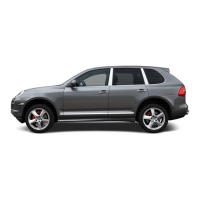
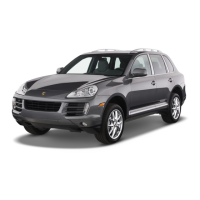



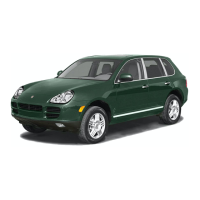
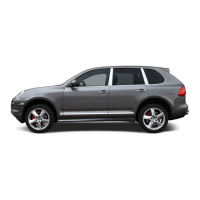

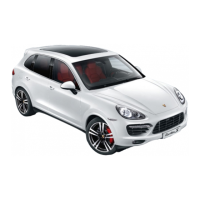



